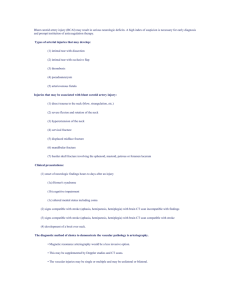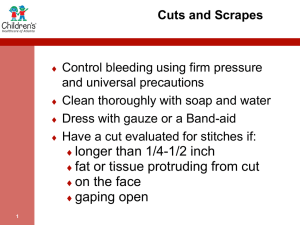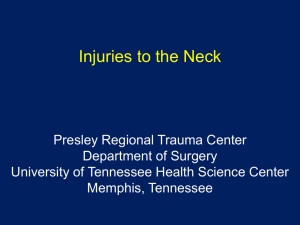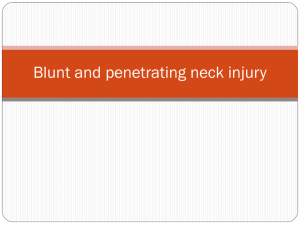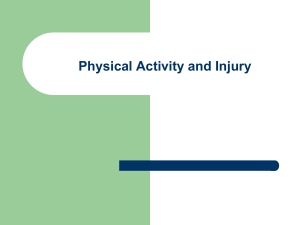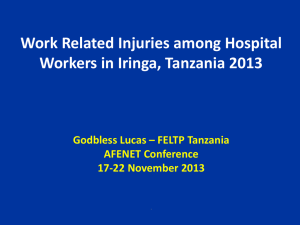Neck Trauma
advertisement
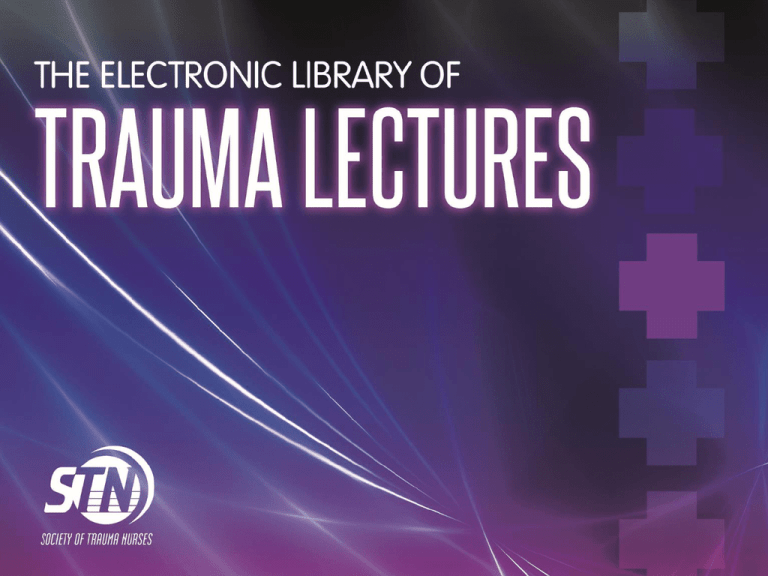
Neck Trauma Objectives At the conclusion of this presentation the participant will be able to: • Examine the spectrum of neck trauma, the mechanisms of injury and associated injury patterns • Define the three zones of the neck used as classifications of injury • Identify the appropriate diagnostic modalities used to evaluate patients with neck trauma • Explain the therapeutic interventions in the management of neck trauma • Identify nursing interventions important in caring for patients with neck trauma Epidemiology • • • • • 3500 deaths per year Mortality rate 2-6% Blunt mechanism accounts for 5% Penetrating trauma accounts for most Zone I injuries are the most lethal Epidemiology • Commonly injured vessels • Internal jugular vein • Internal carotid artery • Laryngeal and tracheal more common than pharyngeal and esophageal injuries Blunt Mechanism of Injury • • • • • Steering wheel Assault Strangulation/Hanging “Clothes line” injuries Other (sports, industrial, etc.) Penetrating Mechanism of Injury • Missile injury (bullet, knife, or other) • Stabbing or lacerations • Impalement • Animal bites Anatomical Review Fascia Superficial fascia Deep cervical fascia Structures at Risk Musculoskeletal Glandular • Vertebral bodies • Cervical muscles and tendons • Clavicles, 1st and 2nd ribs • Hyoid bone • • • • Thyroid Parathyroid Submandibular Parotid glands Anatomical Review Structures at Risk Visceral structures • • • • • Thoracic duct Esophagus Pharynx Larynx Trachea Structures at Risk Structures at Risk Zones of the Neck • Zone III - Clavicles and sternal notch to cricoid cartilage • Zone II – Cricoid cartilage to the angle of mandible • Zone I – Angle of mandible to base of skull III II I Zones of the Neck Zone I Zone II Zone III Zone I • Subclavian vessels • Brachiocephalic veins • Common carotid arteries • Aortic arch • Jugular veins • Esophagus • Lung apices • C- spine/cord • Cranial nerve roots Zone II • Carotid and vertebral arteries • Jugular veins • Pharynx • Larynx • Trachea • Esophagus • C-spine/cord Zone III • Salivary and parotid glands • Esophagus • Trachea • Vertebral bodies • Carotid arteries • Jugular veins • Cranial Nerves IXXII History and Physical History and Physical • Gun • Caliper, distance • Knife • • • • • Length, angle Amount of blood loss Baseline mental status Baseline motor status Drug or alcohol use Key Findings Hard signs Soft signs • Airway obstruction • Pulsatile bleeding • Expanding hematoma • Unresponsive to resuscitation • Extensive subcutaneous emphysema • • • • • Voice change Wide mediastinum Hemoptysis Hematemesis Dysphonia/dysphagia Management - Primary Survey • ABCs • Ensure airway is patent • Ensure patient is adequately oxygenating • Control any obvious hemorrhaging • IV access Airway Considerations Who requires immediate intubation? • Apneic • Comatose • Respiratory compromise • Expanding neck hematoma • Massive subcutaneous emphysema • Massive bleeding in airway Airway Considerations • “Wait and See” • Avoid excessive bag-valve-mask • Exercise caution with paralytics and sedation • Surgical airway last resort • Cricothyrotomy vs. tracheostomy Control Bleeding • • • • http://chestofbooks.com Local pressure only No tourniquets No pressure dressings No probing or blind clamp placement Physical Exam • Violation of the platysma muscle • CNS exam • Obvious hematoma, bleeding Physical exam • • • • • • • • Contusions, lacerations, abrasions to the neck, etc. Expanding hematomas, obvious bleeding Hoarseness, stridor, Subcutaneous emphysema Hemoptysis, drooling Dyspnea Distortion of the normal anatomic landmarks Mandibular/midface instability Diagnostic Studies • Chest radiograph • CT and CT angiogram • • • • Laryngeal injury Tracheal injury Vessels Blunt esophageal injury Diagnostic Studies CT Scan • Can aid in identifying weapon trajectory and structures at risk • Should only be used in stable patients • Gracias et al (2001) found that use of CT scan in stable patients • • Saved patients from arteriogram indicated by older protocols 50% of the time Avoided esophagoscopy in 90% of patients who might otherwise have undergone it Diagnostic Studies • Laryngoscopy • Bronchoscopy • Esophagoscopy; esophagram • Rigid vs. flexible esophagoscopy • Color flow doppler, duplex ultrasonography • MRA Diagnostic Studies Arteriogram • • • • • • • Gold standard Invasive Complications Availability varies Expensive Contrast load Simultaneous intervention Specific Injuries • • • • Vascular Aerodigestive Cranial nerves Thoracic duct Vascular Injuries in the Neck Physical Exam • • • • • • • External marks Decreased LOC Hemiparesis Hematoma Hypotension Dyspnea Thrill, bruit, pulse not present Associated Injuries • • • • • • Le Fort II or III fractures Basilar skull fracture involving the carotid canal Diffuse Axonal Injury with GCS < 6 Cervical vertebral body fracture Near hanging with anoxic brain injury Seatbelt abrasion of anterior neck with significant swelling/altered mental status Primary Diagnostics • • • CT angiogram of the neck Chest x-ray indicated in Zone I injuries because of their proximity to the chest Complete blood count, basic metabolic panel, toxicology and blood alcohol content Primary Diagnostics Vascular Injury Management • Common carotid: repair preferred over ligation in almost all cases • Internal carotid: Shunting is usually necessary • Vertebral: Angiographic embolization or proximal ligation can be used if the contralateral vertebral artery is intact • Internal Jugular: Repair vs. ligation Carotid Intimal Flap Carotid Artery Interposition Repair Management Summary Vascular Injury • Surgical exploration unstable and stable Zone II • Angiography for Zone I and III • Selective, nonoperative management stable Zone II • Embolization high carotid or vertebral artery • Endovascular stent (pseudoaneurysms) • Anticoagulation blunt carotid/vertebral artery Aerodigestive Injuries • Airway structures • Trachea • Larynx • Thyroid cartilage • Esophagus • If diagnosis < 24 hours • Poor outcome if diagnosed > 24 hours • Pharyngeal Tracheal and Laryngeal Injuries Signs of injury • Hoarseness and dysphonia • Hemoptysis • Subcutaneous emphysema in the neck and trunk • Tenderness over the trachea Primary Diagnostics Laryngotracheal Injury Teeth SubQ air • Plain x-rays • • • Soft tissue emphysema Airway compression Fracture of laryngeal cartilages • CT scan • 3D reconstruction • Endoscopy • • Flexible vs. rigid Bronchoscopy/laryngoscopy Cervical Spine Management Laryngotracheal Injury • Secure the airway • Early repair • Laryngeal fractures • • Thyroid fracture most common Delay of reduction makes it more difficult and return of normal function unlikely Esophageal Injury Penetrating • Sharp weapon (knife) • High speed projectile (bullet) • Iatrogenic laceration • Lumen outward injury Esophageal Injury Blunt • • • • Barotrauma Blast injuries Crush injuries Blow to the neck Esophageal Injury Signs of Injury • • • • • • • • Hematemesis Odynophagia Dysphagia Drooling, hypersalivation Tracheal deviation Sucking neck wound Subcutaneous emphysema Pain with turning neck Esophageal Injury Diagnostics Radiographic Findings • Plain films • • • Air in soft tissue planes Pneumomediastinum Leakage of fluid into right pleural space Laboratory Findings • Markers of inflammatory response • • • Contrast swallow • Extravasation is diagnostic • CT scan • Leukocytosis with left shift Low oxygen saturations Acidosis on ABG Esophageal Injury Diagnostics Helical CT • Expedites diagnosis • Trajectory of missile • Associated injuries Diagnostics Esophageal Injuries Normal Thoracic Leak Esophageal Injury Management Summary • Initial assessment complex • Goal is to minimize the bacterial contamination and enzyme erosion • Gastric decompression • Antibiotic coverage • Drainage of wound • Surgical repair Pharyngeal/Oral Injury Similar presentation as esophageal injury Practice Guidelines • Few published practice guidelines for the management of neck injuries • Eastern Association for the Surgery of Trauma (EAST) • Penetrating neck injuries only • Blunt cerebrovascular injury EAST Guidelines Key Points • Selective operative management vs. mandatory exploration • CT Angiography and duplex ultrasound can be used to identify Zone II arterial injuries • Plain CT of the neck can be used to rule out a significant vascular injury • Contrast esophagography or esophagoscopy can be used to evaluate for perforation. • Serial physical examination is 95% sensitive for detecting arterial and aerodigestive tract injuries that need repair EAST Guidelines Summarized • Selective management is common now in asymptomatic patients; • CT angiography is a very good tool to rule out vascular injuries • The role of physical exam, esophagography, and esophogoscopy remains controversial Do all patients have to lay flat? • Position patient in manner that is most comfortable • Patients with anterior neck trauma may want to lean forward or sit upright • Patients with copious secretions can be rolled on their side Possible Complications • Loss of airway • Swallowing problems with aspiration • Stroke in unrecognized vascular injuries • Soft tissue necrotizing infections, including mediastinitis due to delayed diagnosis of esophageal injuries • Air embolism • Pneumothorax, tension pneumothorax Nursing Considerations Be alert for: • Mental status changes and motor deficits • Changes in airway patency • Onset of stridor, drooling • Difficulty laying supine • Other injuries that are highly associated with cerebral vascular injuries Nursing Assessment • Frequent neurologic and motor checks • Frequent assessment for expanding hematomas in the neck • Careful history documentation • Reassurance • Adequate pain assessment • Anxiety reduction Summary • Penetrating and blunt neck trauma occurs in 5-10% of patients with serious injuries • Maintenance of an adequate airway is paramount to survival • Maintain a healthy respect for initially benign appearing injuries • Unrecognized vascular or aerodigestive injuries have a high mortality
